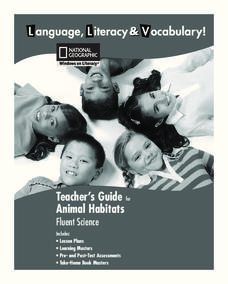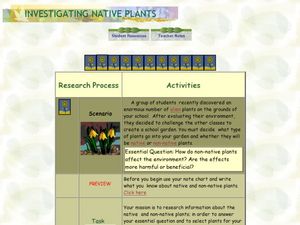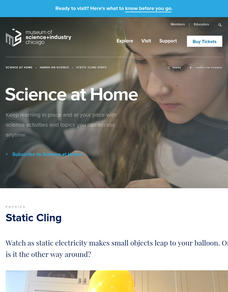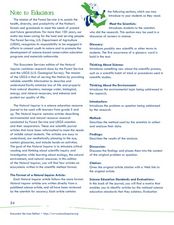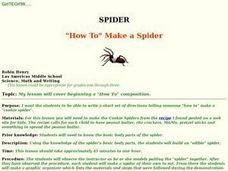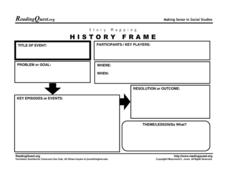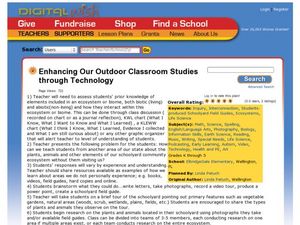Core Knowledge Foundation
A Time for All Seasons - Summer
The sun is shining and the birds are singing, what better time to teach young learners about the fun season of summer. In this week-long science series, children learn how the rotation and orbit of the earth influence...
National Geographic
Animal Habitats
Explore animal habitats and reinforce speaking, listening, reading comprehension, and writing skills with a unit that focuses on the Arctic, desert, ocean, prairie, and rainforest. Enthusiastic scientists read informational text to...
Science Companion
Simple Machines Design Project
Make your work as a teacher a little easier with a physical science project on simple machines. After introducing young scientists to these devices and identifying their different uses around the school, this project engages...
Curated OER
Investigating Native Plants
Students explore Earth science by participating in a gardening activity. For this botany lesson, students discuss a group of non-native plants that would grow well in a school garden. Students complete a plant science graphic organizer...
Curated OER
Make a Key to Identify Animals
In this developing a graphic organizer about animals worksheet, students make a key to identify animals that live in water, does or doesn't have legs, eats meat, flies, grows from a tadpole, and has a shell. Students write 12 short answers.
Museum of Science
Static Cling
Cling to a lesson on static electricity. Pupils take part in experiments where they see how paper from hole punchers, packing peanuts, puffed rice cereal, and other items react when placed near a rubbed balloon. They learn how electrons...
Genesis Energy
Harnessing Solar Energy
How does additional daylight hours affect people and nature? With the help from the legend Maui and the Sun and a grand conversation, scholars complete a graphic organizer to distinguish between the positive and...
Wilderness Classroom
Pollution
Educate scholars on pollution—air, water, and land—with a series of lessons that begin with a thorough explanation of each type. Learners then take part in three activities to reinforce the importance of reducing pollution. They...
Curated OER
Fact or Fantasy?
Are we alone in the universe? This brief informational text on extraterrestrial theory has been split into seven sections to help scholars practice note taking. They read the statements, underlining key words. Then, using the graphic...
Curated OER
KWL Graphic Organizer
In this graphic organizer worksheet, students fill in a KWL chart. They organize information using the "what I know, what I want to know, and what I learned" sections of the chart.
Curated OER
Natural Inquirer Ecosystem Article Lesson
Young scholars discover new ways to preserve the ecosystem by completing graphic organizers. In this environmental lesson, students read an article from the Natural Inquirer in small groups and fill out a graphic organizer based on...
Cornell Lab of Ornithology
Investigating Evidence
Explore the scientific process through nature. Scholars become scientists as they develop a question, design an experiment, collect data, and analyze their results. A two-week lesson guides your classes through the process and provides...
Lerner Publishing
Meet the Dinosaurs
Take your class of youngsters on a prehistoric adventure with this four-lesson series on dinosaurs. Accompanying the Meet the Dinosaurs books by Don Lessem, these lessons engage children in writing their own dinosaur books,...
Curated OER
Science – How Living Things are Grouped
In this classification of living things instructional activity, students respond to 7 short answer, 10 true or false, 4 multiple choice, and 4 graphic organizer questions regarding how living things are grouped.
Curated OER
Creating a Wild Family Album
Third graders choose an animal to research and create a portfolio about that animal that includes information from at least three resources, a graphic organizer, maps, food webs, and captioned pictures.
Curated OER
Spider "How To" Make a Spider
Young chefs follow the set-by-step instructions of a recipe and use their prior knowledge of the body parts of a spider to make edible spider cookies. After completing a pre-writing graphic organizer they then write a "how to"...
Curated OER
Steps of the Scientific Method
This graphic organizer would be quite handy for making an overhead transparency and posting it for learners to view while doing any kind of sceince inquiry/experiment. This is a tried-and-true method, and is very important for any...
Curated OER
Vehicle Graphic Organizer
A two-slide presentation shows learners how to design a car. The first slide has them list the color, number of wheels, and a drawing of the vehicle. The second slide has them list all of the materials they will need to build it.
Student Handouts
Before-and-After Chart
Keep track of what happens before and after an event, moment in a story, and so on, with a clear graphic organizer. Learners can note down four things that happen before and four that happen after on this chart.
Raymond C. Jones
Story Mapping History Frame
Map out the conflicts throughout history with a graphic organizer. It includes a section for kids to list the participants in an event, the problems or goals, and the theme or lesson learned.
Curated OER
Sweet Science: How Sugar Molecules are Manipulated in Candy Making
Students investigate how heat affect sugar solutions. In this science lesson, students compare the sweetness of different types of sugars. They research the development of sugar and create a timeline.
Curated OER
Saltwater Science
Students conduct an experiment that shows them how salt water allows things to float. In this salt water lesson plan, students mix ingredients together to create salt water and observe how it makes the oceans dense. They then interpret...
Curated OER
Enhancing Our Outdoor Classroom Studies through Technology
Combine science, math, and more using this resource. Learners use technology to share video and other information about their community with people throughout the state. They learn about the environment, identifying native plants, record...
Curated OER
Peek at the Chesapeake!
Students research organisms that live in the Chesapeake Bay ecosystem. In this science lesson, students choose an organism and research how it is affected by humans. Students create a presentation of their findings.

